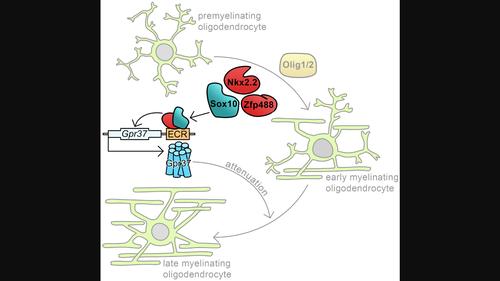Our official English website, www.x-mol.net, welcomes your feedback! (Note: you will need to create a separate account there.)
The myelination‐associated G protein‐coupled receptor 37 is regulated by Zfp488, Nkx2.2, and Sox10 during oligodendrocyte differentiation
Glia ( IF 6.2 ) Pub Date : 2024-03-28 , DOI: 10.1002/glia.24530 Antonia L. Schmidt 1 , Marco Kremp 1 , Takaaki Aratake 1 , Siying Cui 2 , Yifeng Lin 2 , Xiaowen Zhong 3, 4 , Q. Richard Lu 3, 4 , Chengfu Zhang 5, 6 , Mengsheng Qiu 5, 6 , Tim Aberle 1 , Michael Wegner 1
Glia ( IF 6.2 ) Pub Date : 2024-03-28 , DOI: 10.1002/glia.24530 Antonia L. Schmidt 1 , Marco Kremp 1 , Takaaki Aratake 1 , Siying Cui 2 , Yifeng Lin 2 , Xiaowen Zhong 3, 4 , Q. Richard Lu 3, 4 , Chengfu Zhang 5, 6 , Mengsheng Qiu 5, 6 , Tim Aberle 1 , Michael Wegner 1
Affiliation

|
Oligodendrocyte differentiation and myelination in the central nervous system are controlled and coordinated by a complex gene regulatory network that contains several transcription factors, including Zfp488 and Nkx2.2. Despite the proven role in oligodendrocyte differentiation little is known about the exact mode of Zfp488 and Nkx2.2 action, including their target genes. Here, we used overexpression of Zfp488 and Nkx2.2 in differentiating CG4 cells to identify aspects of the oligodendroglial expression profile that depend on these transcription factors. Although both transcription factors are primarily described as repressors, the detected changes argue for an additional function as activators. Among the genes activated by both Zfp488 and Nkx2.2 was the G protein‐coupled receptor Gpr37 that is important during myelination. In agreement with a positive effect on Gpr37 expression, downregulation of the G protein‐coupled receptor was observed in Zfp488‐ and in Nkx2.2‐deficient oligodendrocytes in the mouse. We also identified several potential regulatory regions of the Gpr37 gene. Although Zfp488 and Nkx2.2 both bind to one of the regulatory regions downstream of the Gpr37 gene in vivo, none of the regulatory regions was activated by either transcription factor alone. Increased activation by Zfp488 or Nkx2.2 was only observed in the presence of Sox10, a transcription factor continuously present in oligodendroglial cells. Our results argue that both Zfp488 and Nkx2.2 also act as transcriptional activators during oligodendrocyte differentiation and cooperate with Sox10 to allow the expression of Gpr37 as a modulator of the myelination process.
中文翻译:

少突胶质细胞分化过程中,髓鞘形成相关的 G 蛋白偶联受体 37 受 Zfp488、Nkx2.2 和 Sox10 的调节
中枢神经系统中的少突胶质细胞分化和髓鞘形成由复杂的基因调控网络控制和协调,该网络包含多种转录因子,包括 Zfp488 和 Nkx2.2。尽管在少突胶质细胞分化中的作用已被证实,但人们对 Zfp488 和 Nkx2.2 作用的确切模式(包括它们的靶基因)知之甚少。在这里,我们在分化 CG4 细胞中使用 Zfp488 和 Nkx2.2 的过表达来鉴定依赖于这些转录因子的少突胶质细胞表达谱的各个方面。尽管这两种转录因子主要被描述为抑制因子,但检测到的变化表明其具有作为激活因子的附加功能。 Zfp488 和 Nkx2.2 激活的基因中有 G 蛋白偶联受体 Gpr37,它在髓鞘形成过程中很重要。与 Gpr37 表达的积极作用一致,在 Zfp488 和 Nkx2.2 缺陷的小鼠少突胶质细胞中观察到 G 蛋白偶联受体的下调。我们还确定了几个潜在的监管区域GPR37 基因。尽管 Zfp488 和 Nkx2.2 都与下游的调控区域之一结合GPR37 在体内基因中,没有任何一个调控区域是由任一转录因子单独激活的。仅在少突胶质细胞中持续存在的转录因子 Sox10 存在的情况下,才观察到 Zfp488 或 Nkx2.2 的激活增加。我们的结果表明,Zfp488 和 Nkx2.2 在少突胶质细胞分化过程中也充当转录激活剂,并与 Sox10 配合,允许 Gpr37 表达作为髓鞘形成过程的调节剂。
更新日期:2024-03-28
中文翻译:

少突胶质细胞分化过程中,髓鞘形成相关的 G 蛋白偶联受体 37 受 Zfp488、Nkx2.2 和 Sox10 的调节
中枢神经系统中的少突胶质细胞分化和髓鞘形成由复杂的基因调控网络控制和协调,该网络包含多种转录因子,包括 Zfp488 和 Nkx2.2。尽管在少突胶质细胞分化中的作用已被证实,但人们对 Zfp488 和 Nkx2.2 作用的确切模式(包括它们的靶基因)知之甚少。在这里,我们在分化 CG4 细胞中使用 Zfp488 和 Nkx2.2 的过表达来鉴定依赖于这些转录因子的少突胶质细胞表达谱的各个方面。尽管这两种转录因子主要被描述为抑制因子,但检测到的变化表明其具有作为激活因子的附加功能。 Zfp488 和 Nkx2.2 激活的基因中有 G 蛋白偶联受体 Gpr37,它在髓鞘形成过程中很重要。与 Gpr37 表达的积极作用一致,在 Zfp488 和 Nkx2.2 缺陷的小鼠少突胶质细胞中观察到 G 蛋白偶联受体的下调。我们还确定了几个潜在的监管区域



























 京公网安备 11010802027423号
京公网安备 11010802027423号